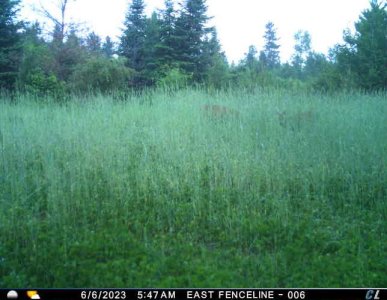View attachment 77543
My doe / fawn groups spend allot of time in the rye / clover. Food, bedding, cover....what is not to like?
I have typically terminated the rye via my crimper in late July.....and on some land just let it reseed itself for the next year. It can become pretty thick that way. Also sometimes I have mowed it ....and have also terminated via spraying for brassica plots. Lots of choices. None are bad.
I think this brief discussion of rye and clover and termination of the rye is an interesting point to talk about. (and this is a chance to expound. grin)
1. Roller crimping before the rye heads become viable seeds happens sometime in July for me....and at the "dough stage" I have a few weeks to decide if I will terminate with the crimper or by some other means.
2. I did an experiment with cultipacking the rye, and by flail mowing the rye, and by roller crimping the rye. Roller crimping by far provided the nicest and most even mulch to cover the clover and did little to diminish the clover below.
3. Mowing the rye with a flail mower did leave a pretty fair mulch but it did not last as long as the roller crimped mulch. Still this is a good method if you also have things like mares tail or other weeds to terminate too.
4. While using my cultipacker will terminate some of the rye....lots more will "bounce back" and continue to go to seed. Maybe not a bad plan if you want to control the amount of rye for the next year?.....but not as effective of a mulch and does little to control weeds. My least favorite method.
5. Spraying with herbicides is useful if you want to plant brassica. I need to use both 24d and gly in order to terminate the clover....or it will typically bounce back and out compete my brassica efforts. Thus a two week plant back time is in order for the 24d.
6. The good thing about clover and rye is that clover will provide the nitrogen credits needed for the brassica crop...and rye also stores decent nitorgen. The mulch and residue and roots all provide for the future crops.....provide little space for weeds to grow.....and mostly eliminates the need for additional fertilizers. Win / win / win.
7. Oftentimes my clover is persistent enough that it will be naturally recurring in the following year(s). Crazy stuff....and all good....and it's comparatively cheap for what it does. And great protein....and provides N credits.
8. Using rye as an annual cover crop practically guarantees an edible food plot in fall.....with almost any meaningful rainfall or dew we get. I put down 112 lbs / acre each fall. (two bags). It's cheap and my deer like to eat it. In spring its again there to provide the first green food at an often desperate time in the deers life.
9. Rye provides really good fawning cover in late May and June....and allows the deer to get away from insects at times.
10. Rye and clover can be drilled "green" prior to terminating or inter-seeded. Very versatile for me
11. Clover and cereal rye go together like peanut butter and jelly. (credit: Lick Creek)
A sprayer, a tractor, a grain drill, and a flail mower are all that is really needed to operate my land. A roller crimper is like icing on the cake. And.....as SD has pondered.....if you owned the right implements....you could always rent the tractor for a few days each year.....and do all the work required.



